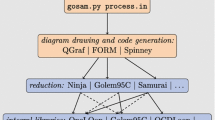Summary
An ambiguity in current algebra sum rules is traced to the use of one good and one bad operator, but will exist even in the absence ofZ-graphs. It is shown that from the work of Gilman and Harari, the dynamical assumptions which ensure the convergence of the dispersion integrals, resolve the ambiguity.
Riassunto
Si fa risalire un'ambiguità nelle regole di somma dell'algebra delle correnti all'uso di un operatore buono ed uno cattivo; ma essa persiste anche in assenza di diagrammiZ. Si dimostra in base ad un lavoro di Gilman e Harari che le ipotesi dinamiche, che assicurano la convergenza degli integrali di dispersione, risolvono l'ambiguità.
Резюме
Неоднозначность в правилах сумм алгебры токов восходит к использованию одного хорощего и одного плохого операторов, но останется даже при отсутствииZ-графиков. Показывается, что из работы Гильмана и Харари динамические предположения, которые обеспечивают сходимость дисперсионных интегралов, разрещают эту неоднозначность.
Similar content being viewed by others
Literatur
B. Renner:Current Algebras and Their Applications (London, 1968).
G. Furlan, F. Lannoy, C. Rossetti andG. Segrè:Nuovo Cimento,40 A, 597 (1965).
S. Fubini, G. Furlan andC. Rossetti:Nuovo Cimento,40 A, 1171 (1965).
K. Bardakci, M. B. Halpen andG. Segrè:Phys. Rev.,158, 1544 (1967).
See for example,S. Gasiorowicz:Elementary-Particle Physics (New York, 1966); Original paper:S. Adler:Phys. Rev.,137, B 1022 (1965).
R. Brout andH. Stern:Phys. Lett.,25 B, 292 (1967).
S. Fubini:Cargèse-Lectures, 1966 (New York, 1967).
F. J. Gilman andH. Harari:Phys. Rev.,165, 1803 (1968).
see ref. (8).
The procedure in this formulation, being manifestly noncovariant, requires the explicit choice of a frame. For the type of sum rule under present discussion, in which we wish the sum to be over states in the ν-channel, the infinite-momentum frame must be taken. Intermediate states of infinite mass contribute a subtraction constant. Formulation ii) of the sum rules appears covariant, but the assumption of a dispersion integral in η with fixed «external masses»q 2, thereby permitting the interpretation of a current commutator integral as a scattering amplitude, implies the choice of the infinite-momentum frame. SeeD. Amati, R. Jengo andE. Remiddi:Nuovo Cimento,51 A, 999 (1967).
see ref. (8).
F. J. Gilman andH. Harari:Phys. Rev.,165, 1803 (1968).
Author information
Authors and Affiliations
Additional information
Postal address: Institute for Theoretical Physics, Arenberg Park, Heverlee.
Traduzione a cura della Redazione.
Переведено редакцией.
Rights and permissions
About this article
Cite this article
Stern, H., Meuldermans, R. Good and bad operators in current algebra sum rules. Nuovo Cimento A (1965-1970) 64, 7–12 (1969). https://doi.org/10.1007/BF02824559
Received:
Published:
Issue Date:
DOI: https://doi.org/10.1007/BF02824559




